Product Images Pregabalin
View Photos of Packaging, Labels & Appearance
- Remedy_Label - Remedy Label
- equation - pregabain gault equation
- fig-01 - pregabalin figure 01
- fig-02 - pregabalin figure 02
- fig-03 - pregabalin figure 03
- fig-04 - pregabalin figure 04
- fig-05 - pregabalin figure 05
- fig-06 - pregabalin figure 06
- fig-07 - pregabalin figure 07
- fig-09 - pregabalin figure 09
- fig-10 - pregabalin figure 10
- fig-11 - pregabalin figure 11
- fig-12 - pregabalin figure 12
- str - pregabalin structure
Product Label Images
The following 14 images provide visual information about the product associated with Pregabalin NDC 70518-4024 by Remedyrepack Inc., such as packaging, labeling, and the appearance of the drug itself. This resource could be helpful for medical professionals, pharmacists, and patients seeking to verify medication information and ensure they have the correct product.
Remedy_Label - Remedy Label
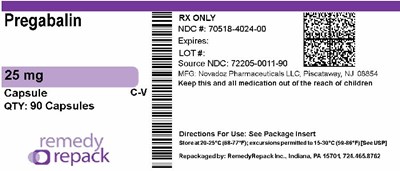
This is a description of a medication called Pregabalin provided in the form of 25 mg capsules with a quantity of 90 capsules. It is manufactured by Novadoz Pharmaceuticals LLC and repackaged by RemedyRepack Inc. The prescription requires an RX and is associated with the National Drug Code (NDC) 70518-4024-00. The storage instructions mention to keep it between 20-25°C (58-77°F) with excursions permitted up to 15-30°C (59-86°F). It is essential to keep this medication out of the reach of children. For detailed usage information, refer to the package insert.*
equation - pregabain gault equation
This text provides a formula for calculating estimated creatinine clearance (CLCr) based on age, weight, and serum creatinine levels. It includes an adjustment for female patients.*
fig-01 - pregabalin figure 01
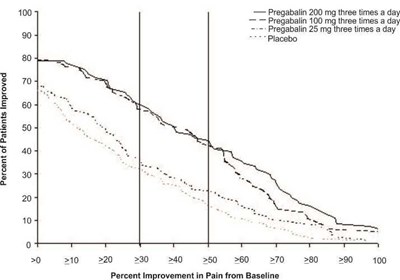
This text provides information on the percentage of patients who have improved using different dosages of pregabalin and a placebo. The data shows the percentage of improvement in pain from the baseline for each treatment group.*
fig-03 - pregabalin figure 03
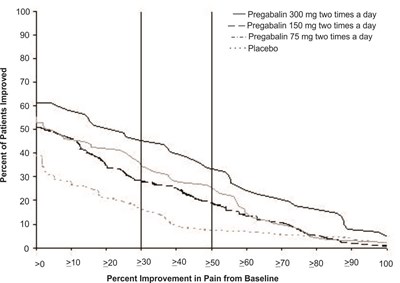
This text provides information on the percentage of patients who improved in terms of pain relief after taking different dosages of Pregabalin. The percentages are shown for Pregabalin dosages of 300mg twice a day, 150mg twice a day, 75mg twice a day, as well as a placebo. The chart also includes the scale of improvement from 0 to 100%.*
fig-04 - pregabalin figure 04
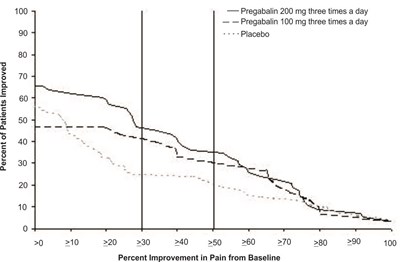
This text provides information on the percentage of patients who improved with different dosages of Pregabalin and a placebo. It also indicates the percentage improvement in pain from baseline.*
fig-05 - pregabalin figure 05
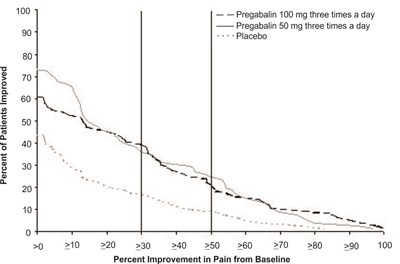
This text provides information on the percentage of patients showing improvement in pain levels based on different treatment options such as Pregabalin 100 mg and 50 mg three times a day. It also includes a visual representation showing the scale of percent improvement in pain from baseline.*
fig-06 - pregabalin figure 06
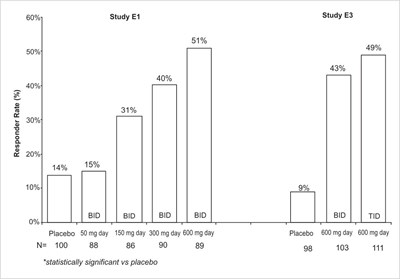
This is a table showing responder rates (%) for different dosages and frequencies of a medication in studies E1 and E3. The table includes placebo groups and shows statistically significant results compared to the placebo. The responder rates range from 9% to 60% in the various conditions tested.*
fig-07 - pregabalin figure 07
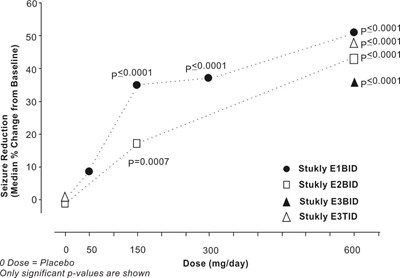
This text contains statistical information such as p-values for different doses in a study, particularly showing that the results are statistically significant. The doses are indicated in milligrams per day and there is a category for placebo for comparison. The data seems to reflect the results of a study or experiment where significance levels were tested.*
fig-09 - pregabalin figure 09
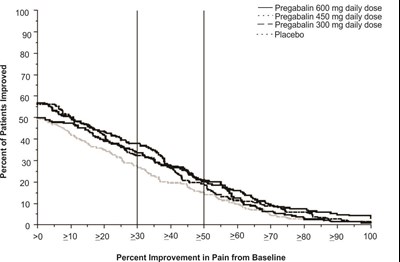
This data shows the percentage of patients who experienced improvement in pain from baseline when taking different doses of Pregabalin (600 mg, 450 mg, and 300 mg) compared to a placebo. The chart indicates the varying levels of improvement in pain, with values ranging from 20% to 100%. This information can be used to evaluate the effectiveness of different doses of Pregabalin in managing pain.*
fig-10 - pregabalin figure 10

This text appears to show an estimated percentage of subjects without LIR (Likely Important Response) for different levels of drug dosage (Pregabalin) and placebo over a specific number of days. The percentages range from 0% to 100%. The time frame mentioned in the data seems to be in days. This information may be part of a study or analysis related to the effectiveness of Pregabalin as compared to a placebo in a certain medical context.*
fig-11 - pregabalin figure 11

This is a chart showing the percentage of subjects who have improved over the course of 12 weeks with Pregabalin compared to Placebo. The data is presented in intervals of 10%, from 0 to 100%, indicating the level of improvement from the baseline.*
fig-12 - pregabalin figure 12
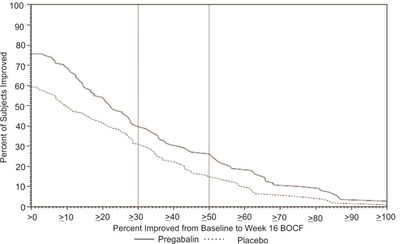
This text provides information on the percentage of subjects improved after receiving treatment with Pregabalin as compared to Placebo from baseline to week 16. The data is presented in a tabular format showing different percentage ranges of improvement.*
* The product label images have been analyzed using a combination of traditional computing and machine learning techniques. It should be noted that the descriptions provided may not be entirely accurate as they are experimental in nature. Use the information in this page at your own discretion and risk.

